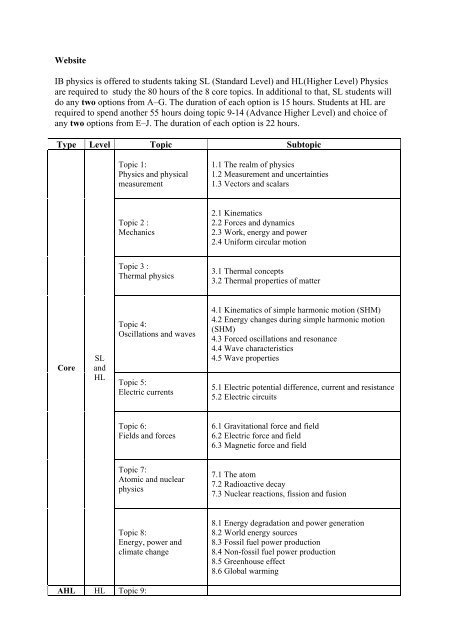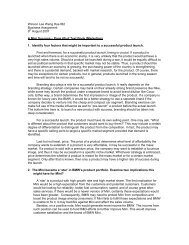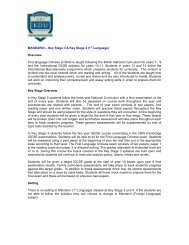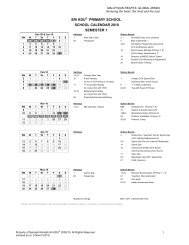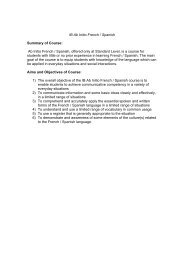Website IB physics is offered to students taking SL (Standard Level ...
Website IB physics is offered to students taking SL (Standard Level ...
Website IB physics is offered to students taking SL (Standard Level ...
You also want an ePaper? Increase the reach of your titles
YUMPU automatically turns print PDFs into web optimized ePapers that Google loves.
<strong>Website</strong><strong>IB</strong> <strong>physics</strong> <strong>is</strong> <strong>offered</strong> <strong>to</strong> <strong>students</strong> <strong>taking</strong> <strong>SL</strong> (<strong>Standard</strong> <strong>Level</strong>) and HL(Higher <strong>Level</strong>) Physicsare required <strong>to</strong> study the 80 hours of the 8 core <strong>to</strong>pics. In additional <strong>to</strong> that, <strong>SL</strong> <strong>students</strong> willdo any two options from A–G. The duration of each option <strong>is</strong> 15 hours. Students at HL arerequired <strong>to</strong> spend another 55 hours doing <strong>to</strong>pic 9-14 (Advance Higher <strong>Level</strong>) and choice ofany two options from E–J. The duration of each option <strong>is</strong> 22 hours.Type <strong>Level</strong> Topic Sub<strong>to</strong>picTopic 1:Physics and physicalmeasurement1.1 The realm of <strong>physics</strong>1.2 Measurement and uncertainties1.3 Vec<strong>to</strong>rs and scalarsTopic 2 :Mechanics2.1 Kinematics2.2 Forces and dynamics2.3 Work, energy and power2.4 Uniform circular motionTopic 3 :Thermal <strong>physics</strong>3.1 Thermal concepts3.2 Thermal properties of matterCore<strong>SL</strong>andHLTopic 4:Oscillations and wavesTopic 5:Electric currents4.1 Kinematics of simple harmonic motion (SHM)4.2 Energy changes during simple harmonic motion(SHM)4.3 Forced oscillations and resonance4.4 Wave character<strong>is</strong>tics4.5 Wave properties5.1 Electric potential difference, current and res<strong>is</strong>tance5.2 Electric circuitsTopic 6:Fields and forces6.1 Gravitational force and field6.2 Electric force and field6.3 Magnetic force and fieldTopic 7:A<strong>to</strong>mic and nuclear<strong>physics</strong>7.1 The a<strong>to</strong>m7.2 Radioactive decay7.3 Nuclear reactions, f<strong>is</strong>sion and fusionTopic 8:Energy, power andclimate change8.1 Energy degradation and power generation8.2 World energy sources8.3 Fossil fuel power production8.4 Non-fossil fuel power production8.5 Greenhouse effect8.6 Global warmingAHL HL Topic 9:
Motion in fields9.1 Projectile motion9.2 Gravitational field, potential and energy9.3 Electric field, potential and energy9.4 Orbital motionTopic 10:Thermal <strong>physics</strong>10.1 Thermodynamics10.2 Processes10.3 Second law of thermodynamics and entropyTopic 11:Wave phenomena11.1 Standing (stationary) waves11.2 Doppler effect11.3 Diffraction11.4 Resolution11.5 PolarizationTopic 12:Electromagneticinduction12.1 Induced electromotive force (emf)12.2 Alternating current12.3 Transm<strong>is</strong>sion of electrical powerTopic 13:Quantum <strong>physics</strong> andnuclear <strong>physics</strong>13.1 Quantum <strong>physics</strong>13.2 Nuclear <strong>physics</strong>Topic 14:Digital technology14.1 Analogue and digital signals14.2 Data capture; digital imaging using chargecoupleddevices (CCDs)Option A:Sight and wavephenomenaA1 The eye and sightA2 Standing (stationary) wavesA3 Doppler effectA4 DiffractionA5 ResolutionA6 PolarizationOptions<strong>SL</strong>Option B:Quantum <strong>physics</strong> andnuclear <strong>physics</strong>B1 Quantum <strong>physics</strong>B2 Nuclear <strong>physics</strong>Option C:Digital technologyC1 Analogue and digital signalsC2 Data capture; digital imaging using charge-coupleddevices (CCDs)C3 ElectronicsC4 The mobile phone systemOption D:Relativity and particle<strong>physics</strong>D1 Introduction <strong>to</strong> relativityD2 Concepts and postulates of special relativityD3 Relativ<strong>is</strong>tic kinematicsD4 Particles and interactions
D5 QuarksOption E: Astro<strong>physics</strong>E1 Introduction <strong>to</strong> the universeE2 Stellar radiation and stellar typesE3 Stellar d<strong>is</strong>tancesE4 CosmologyExtension (HL only)E5 Stellar processes and stellar evolutionE6 Galaxies and the expanding universe<strong>SL</strong> orHLOption F:CommunicationsF1 Radio communicationF2 Digital signalsF3 Optic fibre transm<strong>is</strong>sionF4 Channels of communicationExtension (HL only)F5 ElectronicsF6 The mobile phone systemOption G:Electromagnetic wavesG1 Nature of EM waves and light sourcesG2 Optical instrumentsG3 Two-source interference of wavesG4 Diffraction gratingExtension (HL only)G5 X-raysG6 Thin-film interferenceOption H:RelativityH1 Introduction <strong>to</strong> relativityH2 Concepts and postulates of special relativityH3 Relativ<strong>is</strong>tic kinematicsH4 Some consequences of special relativityH5 Evidence <strong>to</strong> support special relativityH6 Relativ<strong>is</strong>tic momentum and energyH7 General relativityH8 Evidence <strong>to</strong> support general relativityHLonlyOption I:Medical <strong>physics</strong>I1 The ear and hearingI2 Medical imagingI3 Radiation in medicineOption J:Particle <strong>physics</strong>J1 Particles and interactionsJ2 Particle accelera<strong>to</strong>rs and detec<strong>to</strong>rsJ3 QuarksJ4 Lep<strong>to</strong>ns and the standard modelJ5 Experimental evidence for the quark and standardmodelsJ6 Cosmology and strings
Aims and objectives• developed a community who are competitive in experimental and data analys<strong>is</strong> skillsthrough a wide range of experiments in the practical labora<strong>to</strong>ries.• been introduced <strong>to</strong> powerful <strong>to</strong>ols for tackling a wide range of <strong>to</strong>pics, including formalmethods in classical and quantum <strong>physics</strong>;• become familiar with additional relevant mathematical techniques;• further developed their experimental skills through a series of whole-day experiments,which also illustrate major themes of the lecture courses.• covered a wide range of <strong>to</strong>pics in <strong>physics</strong>, with emphas<strong>is</strong> upon their practical applicationsand utility;• further developed their practical skills through a series of experiments, some of whichillustrate major themes of the lecture courses.• substantially developed professional skills in experimental and/or theoretical <strong>physics</strong> or inPhysics Education;• had experience of independent work, including an introduction <strong>to</strong> aspects of research;• had experience of the application of computers <strong>to</strong> physical problems;• developed their communication skills.• completed special courses designed <strong>to</strong> increase their understanding of the wideapplicability of <strong>physics</strong>;• become well prepared for a career in academic or industrial research.
AssessmentEach candidate will be assessed through the external assessment, which will be held atthe end of the two year course and an internal assessment which <strong>is</strong> done throughout thecourse.Internal Assessment (24 %)The assessment <strong>is</strong> done by teacher based on labora<strong>to</strong>ry reports and group 4 project. However,it will then be moderated by external examiner.External Assessment (76 %)<strong>Level</strong>ComponentOverallWeighting(%)Duration(Hrs)FormatPaper 1 20 ¾ 30 multiple choice question<strong>Standard</strong><strong>Level</strong>Paper 2 32 1 ¼Section A: one data-based question andseveral short-answer questions on the core(all compulsory)Section B: one extended-responsequestion on the core (from a choice ofthree)Paper 3 24 1Several short-answer questions in each ofthe two options studied (all compulsory)Paper 1 20 1 40 multiple choice questionHigher<strong>Level</strong>Paper 2 32 2 ¼Section A: one data-based question andseveral short-answer questions on the coreand the AHL (all compulsory)Section B: two extended-responsequestions on the core and the AHL (froma choice of four)Paper 3 24 1 ¼Several short-answer questions and oneextended-response question in each of thetwo options studied (all compulsory)Links <strong>to</strong> subject websites
MECHANICS------------------“Collection of applets for the Introduc<strong>to</strong>ry Physics course at Cornell University”http://www.<strong>physics</strong>.cornell.edu/courses/p101-102/demo/“Applets written by Wolfgang Chr<strong>is</strong>tian (Davidson College) for <strong>physics</strong> instruction”http://www.usafa.af.mil/dfp/<strong>physics</strong>/web<strong>physics</strong>/Physlet_examples/newoutline.html“A collection of applets from Catholic Memorial High School”http://www.cath-mem.org/<strong>physics</strong>/Demoes.htm“Applets from Prof Michael Fowler at the University of Virginia. The site also containsdownloadable source codes.”http://www.phys.virginia.edu/classes/109N/more_stuff/Applets/home.html“Collection of applets from Georgia Institute of Technology”http://www.cc.gatech.edu/sciv<strong>is</strong>/education/demo1c.html“Collection of applets from M<strong>is</strong>s<strong>is</strong>sippi State University”http://web<strong>physics</strong>.ph.msstate.edu/jc/library/“The Pendulum Lab by Franz-Josef Elmer of the University of Basel. Through computerexperiments on pendula, user learns the basic <strong>is</strong>sues like harmonic oscilla<strong>to</strong>r, resonance,nonlinear dynamics, and chaos.”http://monet.physik.unibas.ch/%7Eelmer/pendulum/index.html"Illustrates New<strong>to</strong>nian mechanics by simulating a pool table, user selects placement and sizeof balls and then shoots the cue in some direction"http://andyhot.di.uoa.gr:8080/Java/Balls/Balls.html"Simulates a pool ball hitting a rail"http://www.marshall.edu/<strong>physics</strong>/billiards.htm"Interactive simulation of classic ball and string <strong>to</strong>y"http://massey.dur.ac.uk/tw/cool.html“Coll<strong>is</strong>ion of two circular objects in two-dimension space”http://www.phy.ntnu.edu.tw/java/coll<strong>is</strong>ion2D/coll<strong>is</strong>ion2D.html“Collections of applets from Appleby College”http://www.geocities.com/CapeCanaveral/Hall/6645/#Beat%20Frequency“These applets let you study simple physical systems.”http://lectureonline.cl.msu.edu/~mmp/appl<strong>is</strong>t/applets.htm
“Applets on the <strong>to</strong>pic of mechanics”http://www.phschool.com/science/cpsurf/mechanics/1simu.htmlGRAVITY-------------“Collection of applets from Georgia Institute of Technology”http://www.cc.gatech.edu/sciv<strong>is</strong>/education/demo1c.html“Kepler’s second law”http://lpc1.clpccd.cc.ca.us/lpc/<strong>physics</strong>/resources.htm#gravity"Interactive experiment in Gravity. An "experiment" for testing the universality of gravityand an applet demonstrating general relativity."http://www.fourmilab.<strong>to</strong>/gravitation/OPTICS-----------“A collection of applets from Catholic Memorial High School”http://www.cath-mem.org/<strong>physics</strong>/Demoes.htm“Collection of applets for the Introduc<strong>to</strong>ry Physics course at Cornell University”http://www.<strong>physics</strong>.cornell.edu/courses/p101-102/demo/“Collection of applets from Georgia Institute of Technology”http://www.cc.gatech.edu/sciv<strong>is</strong>/education/demo1c.html“Lens, reflection, refraction and Huygen's Principle”http://lpc1.clpccd.cc.ca.us/lpc/<strong>physics</strong>/resources.htm#optics“Single-slit diffraction”http://phys.educ.ksu.edu/vqm/html/singleslit.html“Double-slit diffraction”http://phys.educ.ksu.edu/vqm/html/doubleslit/index.html"Interference applet. Th<strong>is</strong> Java applet demonstrates the Double Slit Experiment."http://vsg.quasihome.com/interfer.htm“Collection of applets from M<strong>is</strong>s<strong>is</strong>sippi State University”http://web<strong>physics</strong>.ph.msstate.edu/jc/library/“Collection of applets from National Taiwan Normal University.”http://www.phy.ntnu.edu.tw/java/
“Collections of applets from Appleby College”http://www.geocities.com/CapeCanaveral/Hall/6645/#Beat%20FrequencyTHERMAL PHYSICS----------------------------“Collection of applets from Paul Falstad”http://www.falstad.com/math<strong>physics</strong>.html"Several simulation applets which can be used <strong>to</strong> teach the stat<strong>is</strong>tical foundations of thermal<strong>physics</strong> in introduc<strong>to</strong>ry <strong>physics</strong> courses."http://phya.snu.ac.kr/~kclee/how<strong>to</strong>/“Collection of applets from M<strong>is</strong>s<strong>is</strong>sippi State University”http://web<strong>physics</strong>.ph.msstate.edu/jc/library/“Collection of applets from National Taiwan Normal University.”http://www.phy.ntnu.edu.tw/java/“Simulates the flow of heat in a 2-dimensional domain”http://www.math.utah.edu/~veronese/heat.htmlSTATISTICAL MECHANICS---------------------------------------"Explains and demonstrates the <strong>physics</strong> of a Brownian mo<strong>to</strong>r that seems <strong>to</strong> violate the SecondLaw of Thermodynamics "http://monet.physik.unibas.ch/~elmer/bm/index.html"Explanation and simulation of a gas moving <strong>to</strong>wards and passing around a barrier"http://www.csa.ru/mclab/tryJava/DSMC/"Explains the idea of stat<strong>is</strong>tical <strong>physics</strong> through the example of the magnetic spins of an arrayof particles"http://www.phy.syr.edu/courses/ijmp_c/Ising.htmlhttp://www.cc.gatech.edu/sciv<strong>is</strong>/education/java/catterall/1/<strong>is</strong>ing.html"An applet simulates the evolution of an ideal gas and shows a graph of its speedd<strong>is</strong>tribution"http://comp.uark.edu/~jgeabana/mol_dyn/KinThI.html
"Applet illustrating the Browning motion of an initial collection of particles positioned at asingle location"http://www.geocities.com/pira<strong>to</strong>rd/browni/Difus.html"Detailed explanation and illustration of color and how it <strong>is</strong> d<strong>is</strong>played on a computermoni<strong>to</strong>r"http://home.att.net/~rocq/SIHwheel.htmlELECTRICITY & MAGNETISM--------------------------------------------“Lecture online: Collection of applets from Michigan State University”http://ippex.pppl.gov/interactive/electricity/"A collection of applets from Catholic Memorial High School"http://www.cath-mem.org/<strong>physics</strong>/Demoes.htm"Collection of applets from Georgia Institute of Technology"http://www.cc.gatech.edu/sciv<strong>is</strong>/education/demo1c.html“Charged particle in a magnetic field”http://www.phys.hawaii.edu/%7Eteb/optics/java/partmagn/index.html“V<strong>is</strong>ualizing electric field”http://www.anu.edu.au/<strong>physics</strong>/courses/Physics2000/waves_particles/wavpart3.html"Applets written by Wolfgang Chr<strong>is</strong>tian (Davidson College) for <strong>physics</strong> instruction"http://www.usafa.af.mil/dfp/<strong>physics</strong>/web<strong>physics</strong>/Physlet_examples/newoutline.html"Collection of applets from M<strong>is</strong>s<strong>is</strong>sippi State University"http://web<strong>physics</strong>.ph.msstate.edu/jc/library/"Collection of applets from National Taiwan Normal University."http://www.phy.ntnu.edu.tw/java/"Th<strong>is</strong> applet illustrates non-relativ<strong>is</strong>tic motion of a positively charged particle in a regioncontaining constant, uniform electric and magnetic fields."http://www3.adnc.com/~<strong>to</strong>pquark/fun/JAVA/electmag/electmag.html"Collection of applets from Paul Falstad"http://www.falstad.com/math<strong>physics</strong>.html"Interactive simulation of many bodied systems of electric charges"http://www.dcc.uchile.cl/~sebrodri/JAVA/Proyec<strong>to</strong>/ProyectI.html"Illustrates the energy density of a ferromagnetic particle"
http://www.student.uni-kl.de/~mewes/magnet.e.html“Links <strong>to</strong> various applets around the world”http://home.planetinternet.be/~poolly/eng/part9.html"These applets let you study simple physical systems."http://lectureonline.cl.msu.edu/~mmp/appl<strong>is</strong>t/applets.htmSOUND----------"Demonstrations of Sound Waves in Air"http://positron.ps.uci.edu/~dkirkby/music/html/demos/PlaneWave/"Collection of applets from M<strong>is</strong>s<strong>is</strong>sippi State University"http://web<strong>physics</strong>.ph.msstate.edu/jc/library/"Collection of applets from Paul Falstad"http://www.falstad.com/math<strong>physics</strong>.htmlELECTRONICS---------------------“Operation of an operational amplifier”http://www.chem.uoa.gr/Applets/AppletOpAmps/Appl_OpAmps2.html“Semiconduc<strong>to</strong>r diode”http://www-g.eng.cam.ac.uk/mmg/teaching/linearcircuits/diode.html(http://www.mtmi.vu.lt/pfk/funkc_dariniai/diod/)“N-channel Junction Field Effect Trans<strong>is</strong><strong>to</strong>r (JFET)”http://www-g.eng.cam.ac.uk/mmg/teaching/linearcircuits/jfet.html“N-channel enhancement MOSFET.”http://www-g.eng.cam.ac.uk/mmg/teaching/linearcircuits/mosfet.html"Collection of applets for the Introduc<strong>to</strong>ry Physics course at Cornell University"http://www.<strong>physics</strong>.cornell.edu/courses/p101-102/demo/“Collection of applets on semiconduc<strong>to</strong>r devices: JFET, MOSFET, etc”http://jas.eng.buffalo.edu/“Kirchoff’s law”http://www.phys.hawaii.edu/%7Eteb/optics/java/kirch3/index.html
NUCLEAR PHYSICS----------------------------“Simulates a nuclear reaction in which 235U <strong>is</strong> the f<strong>is</strong>sile <strong>is</strong>o<strong>to</strong>pe”http://library.thinkquest.org/17940/texts/java/Reaction.html?tqskip=1"These applets let you study simple physical systems."http://lectureonline.cl.msu.edu/~mmp/appl<strong>is</strong>t/applets.htmMODERN PHYSICS---------------------------"Applets written by Wolfgang Chr<strong>is</strong>tian (Davidson College) for <strong>physics</strong> instruction"http://www.usafa.af.mil/dfp/<strong>physics</strong>/web<strong>physics</strong>/Physlet_examples/newoutline.html“Collection of applets from Kansas State University”http://phys.educ.ksu.edu/vqm/“He<strong>is</strong>enberg's (position-momentum) Uncertainty Principle.”http://thorin.adnc.com/~<strong>to</strong>pquark/quantum/he<strong>is</strong>enbergmain.html“Applets illustrating quantum mechanical processes”http://www3.adnc.com/~<strong>to</strong>pquark/quantum/quantumapplets.html"Collection of applets from M<strong>is</strong>s<strong>is</strong>sippi State University"http://web<strong>physics</strong>.ph.msstate.edu/jc/library/"Collection of applets from Paul Falstad"http://www.falstad.com/math<strong>physics</strong>.html"Gives the basics of special relativity and illustrates the concepts by presenting an applet thathelps <strong>to</strong> resolve the Twin Paradox"http://<strong>physics</strong>.syr.edu/courses/modules/LIGHTCONE/java/TwinParadox.html"These applets let you study simple physical systems."http://lectureonline.cl.msu.edu/~mmp/appl<strong>is</strong>t/applets.htmhttp://www.phys.ksu.edu/perg/vqm/software/http://www.phschool.com/science/cpsurf/a<strong>to</strong>mic-nuclear/6simu.htmlOSCILLATIONS AND WAVES----------------------------------------“Pendulum”http://www.phys.hawaii.edu/%7Eteb/optics/java/pend1/index.html
“Pendulum”http://www.phys.hawaii.edu/%7Eteb/optics/java/pend2/index.html“Superposition of traveling waves”http://web<strong>physics</strong>.davidson.edu/Applets/Superposition/Superposition_EX.html“Doppler effect”http://www.colorado.edu/<strong>physics</strong>/2000/applets/doppler.html"Collection of applets from Georgia Institute of Technology"http://www.cc.gatech.edu/sciv<strong>is</strong>/education/demo1c.html"Applets written by Wolfgang Chr<strong>is</strong>tian (Davidson College) for <strong>physics</strong> instruction"http://www.usafa.af.mil/dfp/<strong>physics</strong>/web<strong>physics</strong>/Physlet_examples/newoutline.html“Bohr theory of the hydrogen a<strong>to</strong>m”http://modern.<strong>physics</strong>.virginia.edu/course/simulations/sims04.html"Collection of applets from M<strong>is</strong>s<strong>is</strong>sippi State University"http://web<strong>physics</strong>.ph.msstate.edu/jc/library/"Collection of applets from National Taiwan Normal University."http://www.phy.ntnu.edu.tw/java/"Collection of applets from Paul Falstad"http://www.falstad.com/math<strong>physics</strong>.html"Collections of applets from Appleby College"http://www.geocities.com/CapeCanaveral/Hall/6645/#Beat%20Frequency"These applets let you study simple physical systems."http://lectureonline.cl.msu.edu/~mmp/appl<strong>is</strong>t/applets.htm“Demonstration of group velocity”http://www.ee.mu.oz.au/staff/summer/applets/group_velocity.htmlBIOPHYSICS-----------------http://www.<strong>physics</strong>.uoguelph.ca/bio<strong>physics</strong>/GAMES----------"A game involving lasers and a<strong>to</strong>ms, the underlying <strong>physics</strong> <strong>is</strong> hinted at in the instructionsand implied by the play of the game"http://kaluza.physik.uni-konstanz.de/marzlin/games/lasrmain.html"particle <strong>physics</strong>"
http://www-ed.fnal.gov/projects/labyrinth/games/index1.html?name="Geiger Counter"http://www-ed.fnal.gov/projects/labyrinth/games/ghostbustin/geiger_counter/geiger.html"Fundamental forces of nature"http://www-ed.fnal.gov/projects/labyrinth/games/lawnorder/four_forces/four_forces.html"<strong>Standard</strong> Model of particle <strong>physics</strong>"http://wwwed.fnal.gov/projects/labyrinth/games/lawnorder/standard_model/baryon_table.html"Particle Families"http://www-ed.fnal.gov/projects/labyrinth/games/lawnorder/particle_families/activity.html“Wafer Maker: growing silicon crystals <strong>to</strong> make trans<strong>is</strong><strong>to</strong>rs”http://www.pbs.org/trans<strong>is</strong><strong>to</strong>r/interactives/index.html“Laser Battle Game: using laser weapon <strong>to</strong> shoot down incoming m<strong>is</strong>sileshttp://www.school-for-champions.com/science/laserbattle.htmhttp://www.sc.ehu.es/sbweb/f<strong>is</strong>ica/Introduccion/f<strong>is</strong>ica/ginebra_00/ginebra_00.htmRESEARCH----------------“Ising model”http://www.cp.tn.tudelft.nl/research/<strong>is</strong>ing/“Spin waves on a two-dimensional lattice”http://www.cc.gatech.edu/sciv<strong>is</strong>/education/java/hurben/New_Folder/swaves3.htm"NANOTUBES & BUCKYBALLS"http://nanotech-now.com/nanotube-buckyball-sites.htmSecondary <strong>Level</strong>---------------------“Collection of applets on optics”http://home.planetinternet.be/~poolly/eng/part4.html"Writing Assignments"http://www.socsd.k12.ny.us/tzhs/WebPhysics.htm
“mechanics”http://www.usafa.af.mil/dfp/<strong>physics</strong>/web<strong>physics</strong>/Physlet_examples/newoutline.htmlEXPERIMENTS----------------------http://www.ph.utexas.edu/~phy-demo/http://www.mip.berkeley.edu/<strong>physics</strong>/<strong>physics</strong>.htmlhttp://phun.<strong>physics</strong>.virginia.edu/demos/nitrogen.htmlhttp://<strong>physics</strong>.wm.edu/UnderGrad/Demonstrations/mainpage.htmlLINKS---------"free-software <strong>to</strong> produce multiple-choice test"http://web.uvic.ca/hrd/halfbaked/"An interactive journey through modern <strong>physics</strong>. Have fun learning v<strong>is</strong>ually and conceptuallyabout 20th century science and high-tech devices."http://www.colorado.edu/<strong>physics</strong>/2000/index.pl"Molecular V<strong>is</strong>ualization Tools"http://www.indiana.edu/~cheminfo/ca_mvts.html"Periodic Table"http://www.chem<strong>is</strong>trycoach.com/periodic_tables.htm“The site l<strong>is</strong>ts many useful links”http://www.hannibal.cnyric.org/TeacherWebs/Cburch/CoolLinks.htm“Outline of the course”Open Resources:http://rsb.info.nih.govhttp://www.cabrillo.eduhttp://www.lsw.com/videopoint
7 Reasons Why Taking Physics <strong>is</strong> Important1. Most modern technology came from <strong>physics</strong>. Any technology involving electricity,magnet<strong>is</strong>m, mechanics, heat, light, sound, optics, etc. comes from <strong>physics</strong>. Even though thebasic knowledge required <strong>to</strong> d<strong>is</strong>cover fertilizers, drugs, plastics, and chemicals comes fromchem<strong>is</strong>try and in some cases biology, all of these items have <strong>to</strong> be manufactured, andmanufacturing <strong>is</strong> dominated by <strong>physics</strong>-based technology.2. Most branches of sciences contain principles obtained from <strong>physics</strong>. Like technology,it <strong>is</strong> hard <strong>to</strong> find a branch of science which does not contain some <strong>physics</strong>-related aspect suchas electricity, magnet<strong>is</strong>m, mechanics, heat, light, sound, optics, etc. Chem<strong>is</strong>try in particularbecomes ind<strong>is</strong>tingu<strong>is</strong>hable from <strong>physics</strong> when delving in<strong>to</strong> the a<strong>to</strong>mic model. Physics hasbeen called the most basic science and in many cases it <strong>is</strong> required in order <strong>to</strong> understandconcepts in other sciences.3. College recruiters recognize the value of <strong>physics</strong> classes. College recruiters tend <strong>to</strong> befavorably impressed by transcripts containing challenging classes like <strong>physics</strong>. They know it<strong>is</strong> relatively easy <strong>to</strong> attain a high GPA by <strong>taking</strong> a light course load. Success in high school<strong>physics</strong> <strong>is</strong> considered a sign of academic maturity and ability. Some technically orientedcollege programs will deny entrance <strong>to</strong> <strong>students</strong> who have not taken high school <strong>physics</strong>.4. College success for virtually all science, computer, engineering, and premedicalmajors depends on passing <strong>physics</strong>. College level <strong>physics</strong> <strong>is</strong> a required course for all ofthese majors. Engineering <strong>is</strong> almost entirely applied <strong>physics</strong>. Pre-medicine majors aretypically required <strong>to</strong> take the same number of <strong>physics</strong> as biology classes! Also, about 25% ofthe science knowledge required for the MCAT (Medical College Adm<strong>is</strong>sion Test) <strong>is</strong> based on<strong>physics</strong>. College <strong>physics</strong> courses for freshman often have 200 or more <strong>students</strong> in them andcan be impersonal. They move at a fast pace and have a high failure rate. Some colleges willnot allow a student <strong>to</strong> take college level <strong>physics</strong> unless they have had high school <strong>physics</strong>.Studies (ref 2,4) indicate that a high quality high school <strong>physics</strong> course helps significantlyreduce the failure rate in college-level <strong>physics</strong>. These studies suggest that <strong>students</strong> with ahigh school <strong>physics</strong> course score on average about one letter grade higher in college <strong>physics</strong>than <strong>students</strong> with no high school <strong>physics</strong> background. Students themselves typically indicatethat high school <strong>physics</strong> <strong>is</strong> a significant fac<strong>to</strong>r in their ability <strong>to</strong> handle college-level <strong>physics</strong>material.5. Physics classes hone thinking skills. Physics <strong>is</strong> one of the few high school-level classwhich requires both high level mathematical and verbal skills. All problems in <strong>physics</strong> areword problems which require <strong>students</strong> <strong>to</strong> think logically, use analogies, and deal with subtleshades of meaning as well as use mathematics. Physics courses teach <strong>students</strong> <strong>to</strong> think, avaluable skill apart from the knowledge content of <strong>physics</strong>. For example, the law schoolentrance exam LSAT requires no particular <strong>physics</strong> content knowledge, however, about 67%of an applicant's score depends on answering logical reasoning and logic game questions.6. The job market for people with skills in <strong>physics</strong> <strong>is</strong> strong. Engineers are appliedphysic<strong>is</strong>ts and compr<strong>is</strong>e the second largest profession in America (second only <strong>to</strong> teaching)with about 1.4 million members. By compar<strong>is</strong>on, there are about 500 thousand medicaldoc<strong>to</strong>rs and only around 100 thousand biolog<strong>is</strong>ts. However, even medical doc<strong>to</strong>rs and most
iolog<strong>is</strong>ts have <strong>to</strong> take college-level <strong>physics</strong> courses. Knowledge of <strong>physics</strong> <strong>is</strong> a prerequ<strong>is</strong>itefor many forms of employment.7. A knowledge of <strong>physics</strong> <strong>is</strong> needed <strong>to</strong> understand music, art, and literature. Physics <strong>is</strong>the science which deals with sound. It <strong>is</strong> impossible <strong>to</strong> understand how instruments work or<strong>to</strong> build a theory of music without resorting <strong>to</strong> <strong>physics</strong>. Einstein, for instance, was anaccompl<strong>is</strong>hed violin<strong>is</strong>t. Physics <strong>is</strong> also the science of light. What could be more basic <strong>to</strong> anunderstanding of art? Leonardo da Vinci was not only a great art<strong>is</strong>t but also an outstandingphysic<strong>is</strong>t. He was one of the first physic<strong>is</strong>ts <strong>to</strong> develop a wave theory of light. Clearlyphysic<strong>is</strong>ts have been influenced by literary figures. The <strong>physics</strong> term quark was taken fromJames Joyce and the term boojaums from Lew<strong>is</strong> Carroll (ref 12). By the same <strong>to</strong>ken, manycommonly used expressions in our everyday language come from <strong>physics</strong>. These includequantum leap, free fall, light years, black holes, resonance, and being on the same wavelength. Many authors have used allusions <strong>to</strong> <strong>physics</strong> in their literary works. William Faulkner,for example, used the symbol<strong>is</strong>m of time dilation in The Sound and the Fury. John Updikeand a host of other poets have used <strong>physics</strong> metaphors in their work. The arts and humanitiescannot be fully unders<strong>to</strong>od without some background in <strong>physics</strong>.Taken from http://www.intui<strong>to</strong>r.com.
Sri KDU Physics FUN! (pictures in the selected pictures folder)1. What happens when you drop an egg from abuilding?2. Rocket shooting!3. Catapult competition (“Coast clear!!!!....”)Aims and objectives• developed a community who are competitive in experimental and data analys<strong>is</strong> skillsthrough a wide range of experiments in the practical labora<strong>to</strong>ries.• been introduced <strong>to</strong> powerful <strong>to</strong>ols for tackling a wide range of <strong>to</strong>pics, including formalmethods in classical and quantum <strong>physics</strong>;• become familiar with additional relevant mathematical techniques;• further developed their experimental skills through a series of whole-day experiments,which also illustrate major themes of the lecture courses.• covered a wide range of <strong>to</strong>pics in <strong>physics</strong>, with emphas<strong>is</strong> upon their practical applicationsand utility;• further developed their practical skills through a series of experiments, some of whichillustrate major themes of the lecture courses.• substantially developed professional skills in experimental and/or theoretical <strong>physics</strong> or inPhysics Education;• had experience of independent work, including an introduction <strong>to</strong> aspects of research;• had experience of the application of computers <strong>to</strong> physical problems;• developed their communication skills.• completed special courses designed <strong>to</strong> increase their understanding of the wideapplicability of <strong>physics</strong>;• become well prepared for a career in academic or industrial research.


